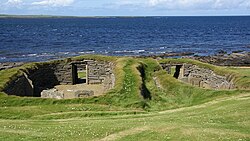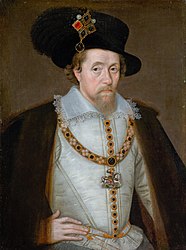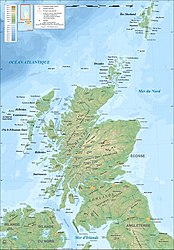Scotland is the country which makes up the northern parts of the island of Britain and the numerous island chains which surround the northern extremities of the land mass. Its geography consists of extensive highlands and mountains in the north. This peculiarity has made it difficult to control militarily and politically and the country's history has been characterized by clashes with more powerful neighbors to the south such as the Romans and then the English who largely failed to pacify the northern stretches of Britain despite repeated efforts. Where force of arms failed, marriage alliances succeeded and in the early seventeenth century Scotland and England were united under one ruler in the shape of King James VI and I of England, Scotland and Ireland, the result of a marriage alliance between the English House of Tudor and the Scottish House of Stuart a century earlier. The two countries have been united ever since and Scotland forms parts of the United Kingdom.[1]
Scottish history

Scotland has a rich prehistory. The Orkney Islands were home to an advanced Neolithic culture by the fourth millennium BCE and the Knap of Howar there is widely believed to be the oldest surviving free-standing stone house in Northern Europe, dating to around 3500 BCE. The settlement of Skara Brae on the Orkneys approximately a thousand years later was developed enough that the houses there had plumbing systems and megalithic monuments appeared in the country around this time as well.[2]
In the first millennium BCE the Caledonians, a Brittonic-speaking Celtic people occupied much of Scotland during the wider Celtic migrations into Western Europe. Centuries later these were one of the few peoples the Romans ever encountered that they failed to conquer. During the reign of Antoninus Pius the Scottish lowlands were occupied and construction of the Antonine Wall was undertaken in 142 CE across Scotland to the Firth of Forth, but after just a few years the walls and fortifications had come under near constant attack from the Caledonians and by the 160s CE the Romans had to retreat southwards to Hadrian’s Wall in northern England.[3]
In medieval times much of western Scotland and the Outer Hebrides were incorporated into the Kingdom of Dal Riata based out of Ulster in northern Ireland, extending Gaelic culture into Scotland.[4] Further newcomers arrived in the shape of the Norse peoples during the Viking Age and parts of the islands and coastlines of Scotland fell temporarily under Norwegian and Danish rule at various points between the ninth and thirteenth centuries. Despite these foreign incursions, a native Kingdom of Scotland managed to emerge as the predominant power in the Scottish lowlands during the High Middle Ages.

Scotland’s history over the last millennium in many ways has focused on its torturous relationship with England. As early as the eleventh century William the Conqueror attempted to make inroads into Scotland and many of his successors as kings of England, particularly King Edward I, viewed Scotland as part of their wider British dominions which they were destined to conquer.[5] At various points Scotland was virtually controlled by England, but it also frequently managed to reassert its independence through a judicious policy of allying with France, England’s perennial enemy across the English Channel in late medieval times, in a relationship referred to in Scotland as ‘the Auld Alliance’.[6]
In the end it was not war or bloodshed that led to Scotland being fully united with England. Instead it was a marriage alliance. King Henry VII of England married his daughter Margaret to King James IV of Scotland in 1503. A century later her great-grandson, King James VI of Scotland, ascended to the throne of England as well when his cousin, Queen Elizabeth I, died without children or a clear heir.[7] This united the thrones of England and Scotland under one ruler and in 1707 the two kingdoms were politically united into one state. They have remained bound ever since, though Scotland has agitated increasingly for independence from England and an exit from the United Kingdom in recent decades.[8]
Scottish geography

Scotland has many distinct geographical regions and has been shaped in many ways by the North Sea, occupying the northern third of the island of Britain. The more densely populated south of the country is low-lying and has developed most culturally towards England. These lowlands give way above the Firth of Forth to the Scottish Highlands, a mountainous rugged terrain which is thinly populated and which remained cultural distinct from the lowlands until quite recently, with Scottish Gaelic spoken widely here until well into the eighteenth century amongst the Scottish clans. Around the Highlands and in general all along the western seaboard of Scotland the country is surrounded by islands, over 800 in all ranging from large islands such as Lewis and Harris, Skye, Islay and Kintyre off the west coast, to the Orkneys off the north-east and much smaller isolated islands such as Sule Skerry and North Rona lying remotely to the north of the country.[9] The main population centers are in the southern lowlands. The capital Edinburgh has a population of approximately half a million people, which is eclipsed by Glasgow, a city of 600,000 people which emerged as a major industrial center from the eighteenth century onwards. Dundee and Aberdeen are the only other major cities.[10]
Family history studies in Scotland
As with the other parts of Britain and Ireland, the first national census was undertaken in Scotland in 1801, with further censuses in 1811, 1821 and 1831. It was not until 1841, though, that the first detailed census providing information on every person recorded in Scottish households and their dates of birth, occupations and other details were produced. Censuses have been produced frequently ever since. For the period prior to the nineteenth century the records of the Scottish Kirk or church are particularly detailed as the Presbyterian Calvinists which came to dominate the country religiously from the middle of the sixteenth century were especially diligent in their record keeping.[11] Copies of a good many of these church and governmental records are held by the National Records of Scotland in Edinburgh.[12] The National Library of Scotland in the same city also holds many useful records for the study of family history and genealogy in Scotland.[13] Inevitably, given the country’s close political ties to England, some pertinent documentary material is held in repositories in London such as the National Archives of the United Kingdom.[14]
Census records on MyHeritage
Explore more about Scotland
- Scotland, Births and Baptisms, 1564-1950 record collection on MyHeritage
- Scotland, Marriages, 1561-1910 record collection on MyHeritage
- 1901 Scotland Census record collection on MyHeritage
- Foundations of Scottish Genealogy at Legacy Family Tree Webinars
- Inheritance in Scotland – Wills, Testaments, and Land Records at Legacy Family Tree Webinars
- Through MyHeritage, Great-Grandmother of 2 is Reunited with Uncles and Aunt She Never Knew Existed on the MyHeritage blog
References
- ↑ https://www.parliament.uk/about/living-heritage/evolutionofparliament/legislativescrutiny/act-of-union-1707/overview/union-of-the-crowns/
- ↑ https://www.worldhistory.org/Skara_Brae/
- ↑ https://www.historic-uk.com/HistoryMagazine/DestinationsUK/The-Antonine-Wall/
- ↑ https://www.britannica.com/place/Dalriada
- ↑ https://www.historyextra.com/period/medieval/edward-i-the-dutiful-conqueror/
- ↑ https://www.historic-uk.com/HistoryUK/HistoryofScotland/The-Auld-Alliance-France-Scotland/
- ↑ https://scottishhistorysociety.com/the-union-of-1603/
- ↑ https://www.history.co.uk/articles/a-brief-history-of-england-and-scotland
- ↑ https://www.embracescotland.co.uk/article/scotland-geography
- ↑ https://www.scotland.org/about-scotland/scotlands-cities
- ↑ https://www.nrscotland.gov.uk/research/guides/census-records/pre-1841-census-records
- ↑ https://www.nrscotland.gov.uk/
- ↑ https://www.nls.uk/
- ↑ https://discovery.nationalarchives.gov.uk/details/a/A13531995